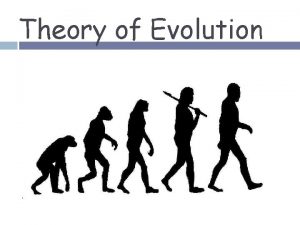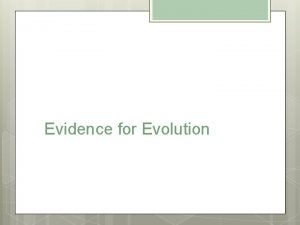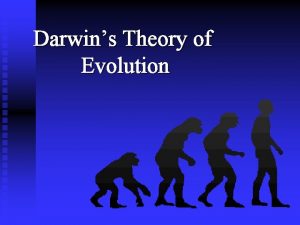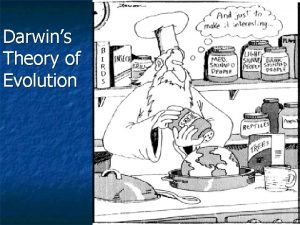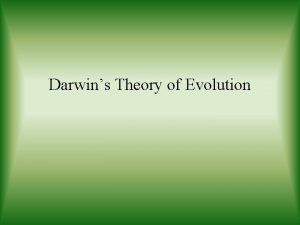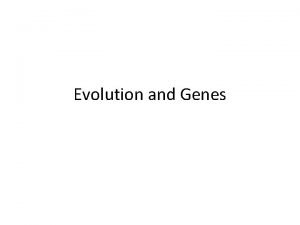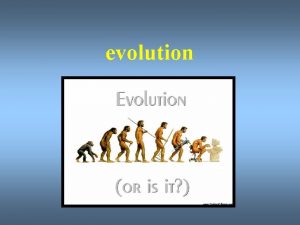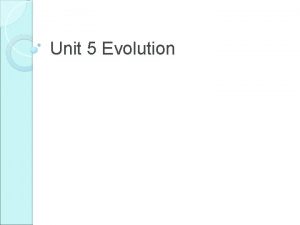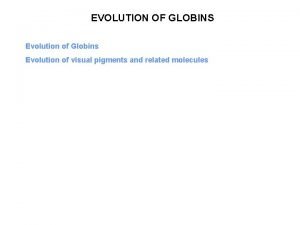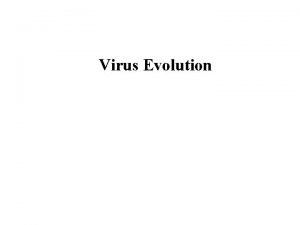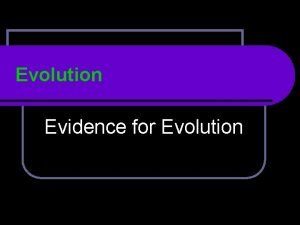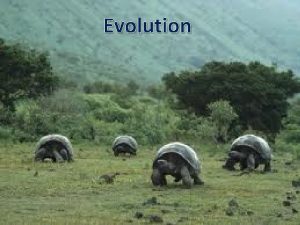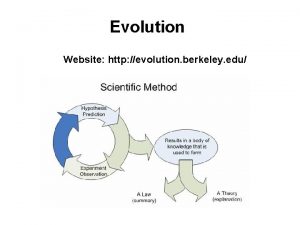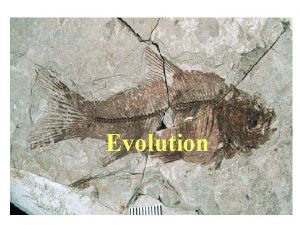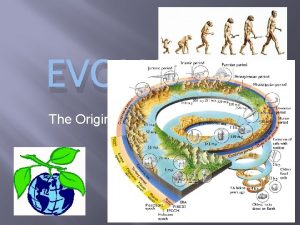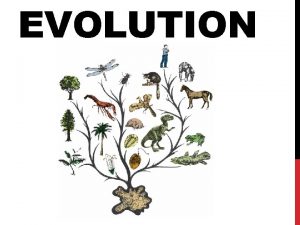THE THEORY OF EVOLUTION THE THEORY OF EVOLUTION
































- Slides: 32

THE THEORY OF EVOLUTION

THE THEORY OF EVOLUTION A scientific theory is an explanation for a set of observation or natural phenomena that has been repeatedly confirmed through experimentation and observations. Theory ≠ fact. The theory of evolution states that all living organisms on Earth share a common ancestor and they have changed over time mostly through the process of natural selection.

THEORIES CAN CHANGE Although scientific theories are supported by a large amount of evidence generated over a long period of time, a scientific theory may change if new evidence contradicts it. A theory may be modified or completely rejected.

CHARLES DARWIN English naturalist 5 year expedition on the HMS Beagle in 1831

CHARLES DARWIN One of his most famous stops was the Galapagos Islands. He noticed the variation present in different populations of organisms and how the adaptations or organisms made them better suited to their environments.

VARIATION? ADAPTATION? Variation—differences Favorable variations help an individual survive and reproduce. Unfavorable variations lead to fewer offspring and extinction. A variation may be favorable in one environment and unfavorable in another. Adaptation—trait that helps organisms of a particular species to survive and reproduce in their unique environment

DARWIN’S OBSERVATIONS Islands had different climates Characteristics of plants and animals varied among islands Tortoise shell shape Bird beak shape What could this mean?

LAMARCK’S THEORY OF EVOLUTION Jean-Baptiste Lamarck was among one of the first scientists to recognize that life had changed over time. He proposed that by selective use or disuse of organs, organisms acquired or lost certain traits during their lifetime. These traits could then be passed on to their offspring. Over time this process led to change in a species.

USE AND DISUSE

DARWIN’S THEORY Darwin began filling notebooks with his ideas. He was disturbed by his findings. In 1858 (22 years after the voyage of the Beagle) Alfred Russel Wallace wrote to Darwin about his own observations. This gave Darwin an incentive to publish his own work.

DARWIN PUBLISHES “On the Origin of Species by Natural Selection” Some considered him to be brilliant, and others strongly opposed and ridiculed his argument. Set the stage for controversy that has continued to this day

ARTIFICIAL SELECTION n People choose which individuals to use for breeding based on the characteristics they would like to see in the offspring. n Largest hogs n Fastest horses n Cows with most milk n Darwin proposed that forces in nature could also influence selection.

FITNESS Fitness—ability of an individual to survive and reproduce in a specific environment. Individuals with lower levels of fitness die or leave few offspring. Individuals with high levels of fitness survive and reproduce most successfully.

NATURAL SELECTION Natural selection is the process by which organisms with favorable variations survive and produce more offspring than less well-adapted organisms. Also known as “survival of the fittest. ”

ARTIFICIAL VS. NATURAL SELECTION In both cases, organisms with certain traits survive better than organisms with other traits. In artificial selection, humans choose which traits are going to be present in the next generation. In natural selection, nature chooses due to survival of the fittest.

ACQUIRED VS. GENETIC TRAITS Acquired traits are picked up by an organism throughout life due to environmental conditions. Ex. Mouse gets its tail cut off, calluses on hands of a carpenter Acquired traits are not passed from one generation to the next. Genetic traits result from genes encoded in the DNA of organisms. Ex. Hair color, blood type Genetic traits are passed from parent to offspring.

POPULATIONS, NOT INDIVIDUALS Natural selections affects populations, not individuals. No two individuals in a population are exactly alike. Organisms vary in genetic traits of size, coloration, structural characteristics and behavior. Individuals with the most adaptive variations survive and pass on those traits to their offspring. Over time, the population will shift, and there will be more individuals with the adaptation.

DIFFERENTIAL REPRODUCTIVE SUCCESS Natural selection causes differential reproductive success. Individuals with a certain variation will produce more offspring than other individuals in a population.

EVIDENCE OF EVOLUTION Fossil Record Biogeography Homologies

THE FOSSIL RECORD – FOSSILS AND ANCIENT LIFE The fossil record provides evidence about the history of life on Earth. It also shows how different groups of organisms, including species, have changed over time. More than 99% of all species that have ever lived on Earth have become extinct.

FOSSIL RECORD Scientists use geological and chemical data to date preserved remains of living organisms from the past. When fossils are arranged chronologically, there is an progressive change in organisms. Fossil records that are almost complete support they theory of common ancestry.

DESCENT WITH MODIFICATION Species today look different from their ancestors. Each has descended, with changes, from other species over time.

SEQUENTIAL EVOLUTIONARY CHANGE The fossil record provides evidence for theory of sequential evolutionary change within groups over time. Older fossils are located in lower layers of rock while younger fossils are located closer to the surface.

PRINCIPLE OF ORIGINAL HORIZONTALITY Layers are put down in order. Youngest on the top, oldest on the bottom.

GAPS IN THE FOSSIL RECORD Overall, fossilization rates are low. Conditions needed for fossilization are very specific. Organisms with soft bodies or small bones do not fossilize well. Gaps in the fossil record continue to be filled as new fossils are discovered, but it is likely that the fossils of some species will never be discovered.

BIOGEOGRAPHY Biogeography is the study of the distribution of species, organisms and ecosystems through geological space and time. Similar fossils and living species are found on unconnected continents supporting the idea of continental drift.

CONTINENTAL DRIFT Continental drift states that there was one land mass (Pangaea) that split into several continents over millions of years.

HOMOLOGIES Homologies are similar features between different organisms resulting from common ancestors. There are three types: Anatomical—similar structures Molecular—similar stretches of genetic material Developmental—similar features in embryos

ANATOMICAL HOMOLOGIES

DEVELOPMENTAL HOMOLOGIES

VESTIGIAL STRUCTURES When a structure is no longer needed as populations change and diversify, it often slowly degenerates until it is nonfunctional. These are called vestigial structures. Ex. Pelvis in a whale Ex. Human appendix

COMMON DESCENT All species, living or extinct, were derived from common ancestors. A single “tree of life” links all living things.
 Hát kết hợp bộ gõ cơ thể
Hát kết hợp bộ gõ cơ thể Ng-html
Ng-html Bổ thể
Bổ thể Tỉ lệ cơ thể trẻ em
Tỉ lệ cơ thể trẻ em Voi kéo gỗ như thế nào
Voi kéo gỗ như thế nào Tư thế worm breton là gì
Tư thế worm breton là gì Chúa yêu trần thế
Chúa yêu trần thế Kể tên các môn thể thao
Kể tên các môn thể thao Thế nào là hệ số cao nhất
Thế nào là hệ số cao nhất Các châu lục và đại dương trên thế giới
Các châu lục và đại dương trên thế giới Cong thức tính động năng
Cong thức tính động năng Trời xanh đây là của chúng ta thể thơ
Trời xanh đây là của chúng ta thể thơ Mật thư anh em như thể tay chân
Mật thư anh em như thể tay chân Phép trừ bù
Phép trừ bù độ dài liên kết
độ dài liên kết Các châu lục và đại dương trên thế giới
Các châu lục và đại dương trên thế giới Thể thơ truyền thống
Thể thơ truyền thống Quá trình desamine hóa có thể tạo ra
Quá trình desamine hóa có thể tạo ra Một số thể thơ truyền thống
Một số thể thơ truyền thống Cái miệng xinh xinh thế chỉ nói điều hay thôi
Cái miệng xinh xinh thế chỉ nói điều hay thôi Vẽ hình chiếu vuông góc của vật thể sau
Vẽ hình chiếu vuông góc của vật thể sau Biện pháp chống mỏi cơ
Biện pháp chống mỏi cơ đặc điểm cơ thể của người tối cổ
đặc điểm cơ thể của người tối cổ Ví dụ về giọng cùng tên
Ví dụ về giọng cùng tên Vẽ hình chiếu đứng bằng cạnh của vật thể
Vẽ hình chiếu đứng bằng cạnh của vật thể Tia chieu sa te
Tia chieu sa te Thẻ vin
Thẻ vin đại từ thay thế
đại từ thay thế điện thế nghỉ
điện thế nghỉ Tư thế ngồi viết
Tư thế ngồi viết Diễn thế sinh thái là
Diễn thế sinh thái là Dot
Dot So nguyen to
So nguyen to

































